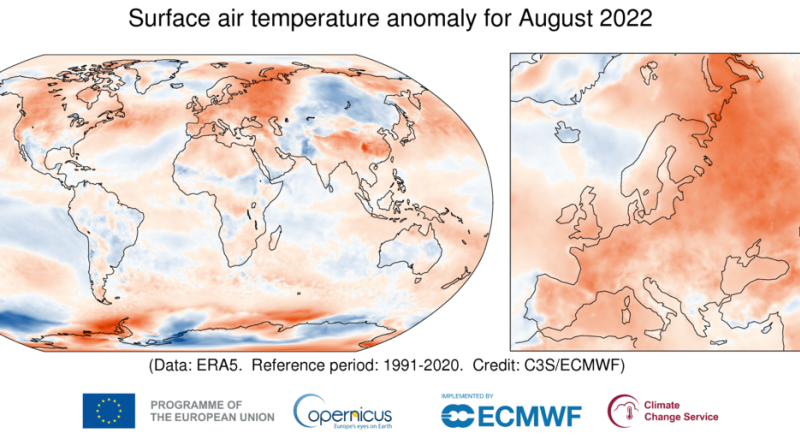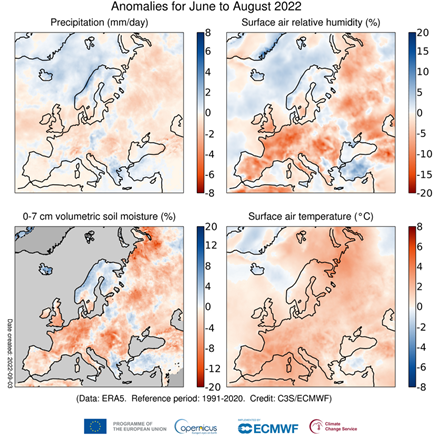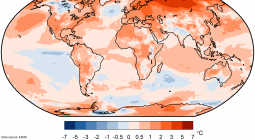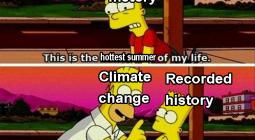Copernicus: Summer 2022 Europe’s hottest on record

The Copernicus Climate Change Service (C3S), implemented by the European Centre for Medium-Range Weather Forecasts on behalf of the European Commission with funding from the EU, routinely publishes monthly climate bulletins reporting on the changes observed in global surface air temperature, sea ice cover and hydrological variables. All the reported findings are based on computer-generated analyses using billions of measurements from satellites, ships, aircraft and weather stations around the world.
August 2022 surface air temperature:
Globally, the average August 2022 temperature was:
- 0.3°C higher than the 1991-2020 average for the month, joint third warmest August on record
- similar to the values for August 2017 and 2021 and within about 0.1°C of the higher values reached in August 2016 and 2019
The average temperature over Europe in 2022 was:
- the highest on record for both August and summer (June – August) by substantial margins of 0.8°C over 2018 for August and 0.4°C over 2021 for summer
- European temperatures were most above average in the east of the continent in August, but were still well above average in the south-west, where they had been high also in June and July
- Heatwaves were prevalent in this part of Europe and over central and eastern China for all three summer months. North America also experienced one of its warmest summers
August 2022 - Hydrological conditions:
- August 2022 was generally much drier than average in much of western and parts of eastern Europe.
- Conversely, it was wetter-than average over most of Scandinavia and parts of southern and southeastern Europe. Southern regions were hit by a “derecho” storm, with extreme winds and rainfall.
- Conditions were also wetter than average in many extratropical regions of North America and Asia: in many locations heavy precipitation triggered floods and inundations. Pakistan saw particularly severe conditions with record breaking rainfall.
- Among the drier-than-average extratropical regions, parts of China experienced severe drought.
Boreal summer 2022 - Hydrological conditions:
- The summer 2022 was characterised by hot and dry conditions over much of western Europe. In much of Scandinavia, regions of central and south-eastern Europe, Greece and western Turkey, conditions were predominantly wetter than average.
- In boreal summer 2022, it was drier than average in central North and South America and across central Asia. The Horn of Africa continued to experience drought. Conditions were predominantly wetter-than-average in south Asia, particularly in Pakistan, in eastern Australia and in most of southern Africa.

Senior Scientist for the Copernicus Climate Change Service, Freja Vamborg, states: “An intense series of heatwaves across Europe paired with unusually dry conditions, have led to a summer of extremes with records in terms of temperature, drought and fire activity in many parts of Europe, affecting society and nature in various ways. The Copernicus Climate Change Service data shows that we’ve not only had record August temperatures for Europe but also for summer, with the previous summer record only being one year old.”
Video material accompanying the maps can be found here.
More information about climate variables in August and climate updates of previous months as well as high-resolution graphics and the video can be downloaded here.
Answers to frequently asked questions regarding temperature monitoring can be found here.
Information about the C3S data set and how it is compiled
Temperature and hydrological maps and data are from ECMWF Copernicus Climate Change Service’s ERA5 dataset.
Sea ice maps and data are from a combination of information from ERA5, as well as from the EUMETSAT OSI SAF Sea Ice Index v2.1, Sea Ice Concentration CDR/ICDR v2 and fast-track data provided upon request by OSI SAF.
Regional area average quoted here are the following longitude/latitude bounds:
Globe, 180W-180E, 90S-90N. over land and ocean surfaces.
Europe, 25W-40E, 34N-72N, over land surfaces only.
More information can be found here.





